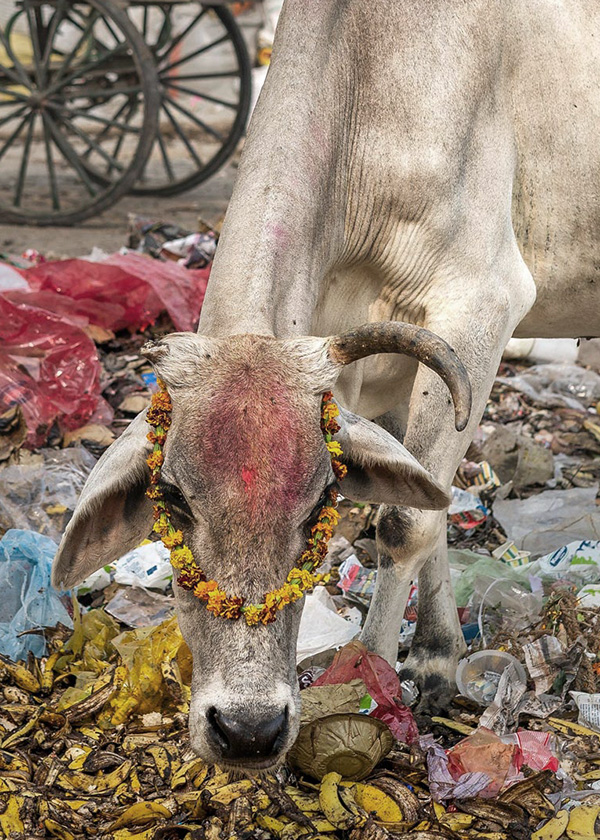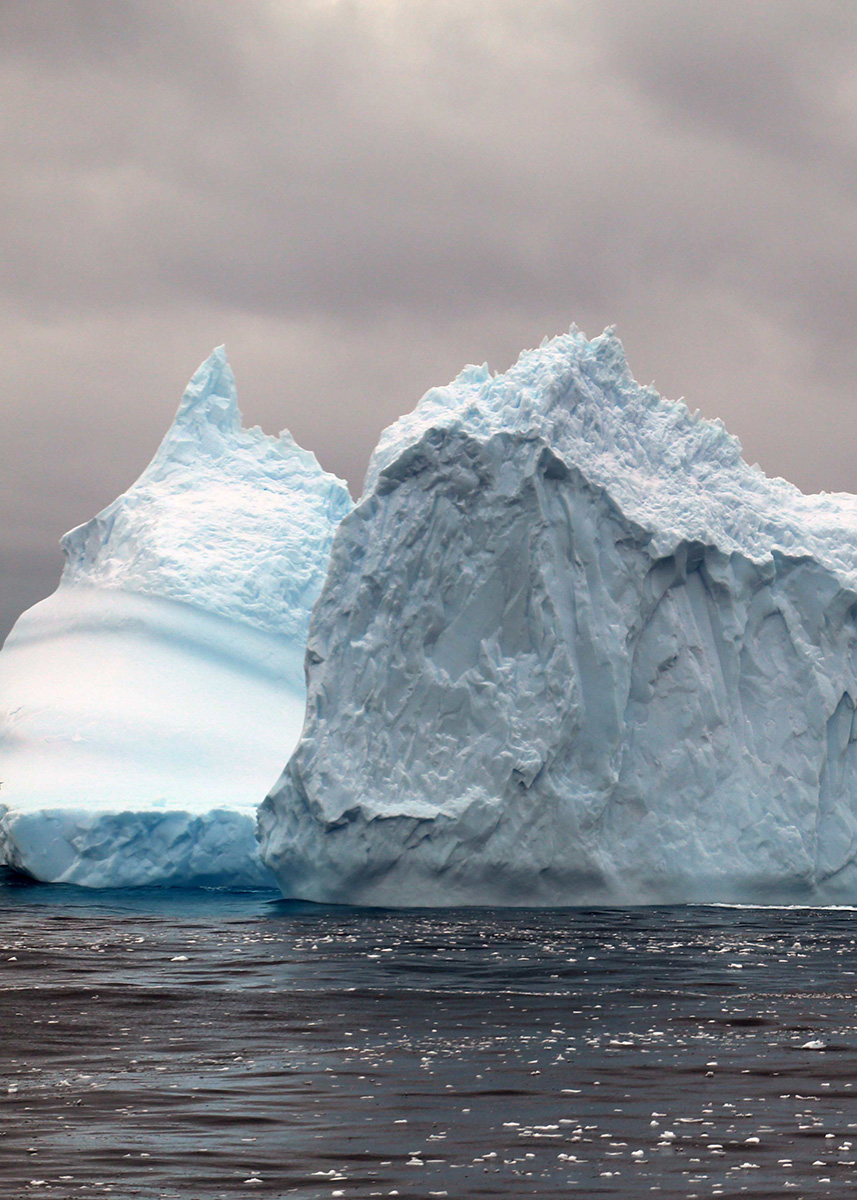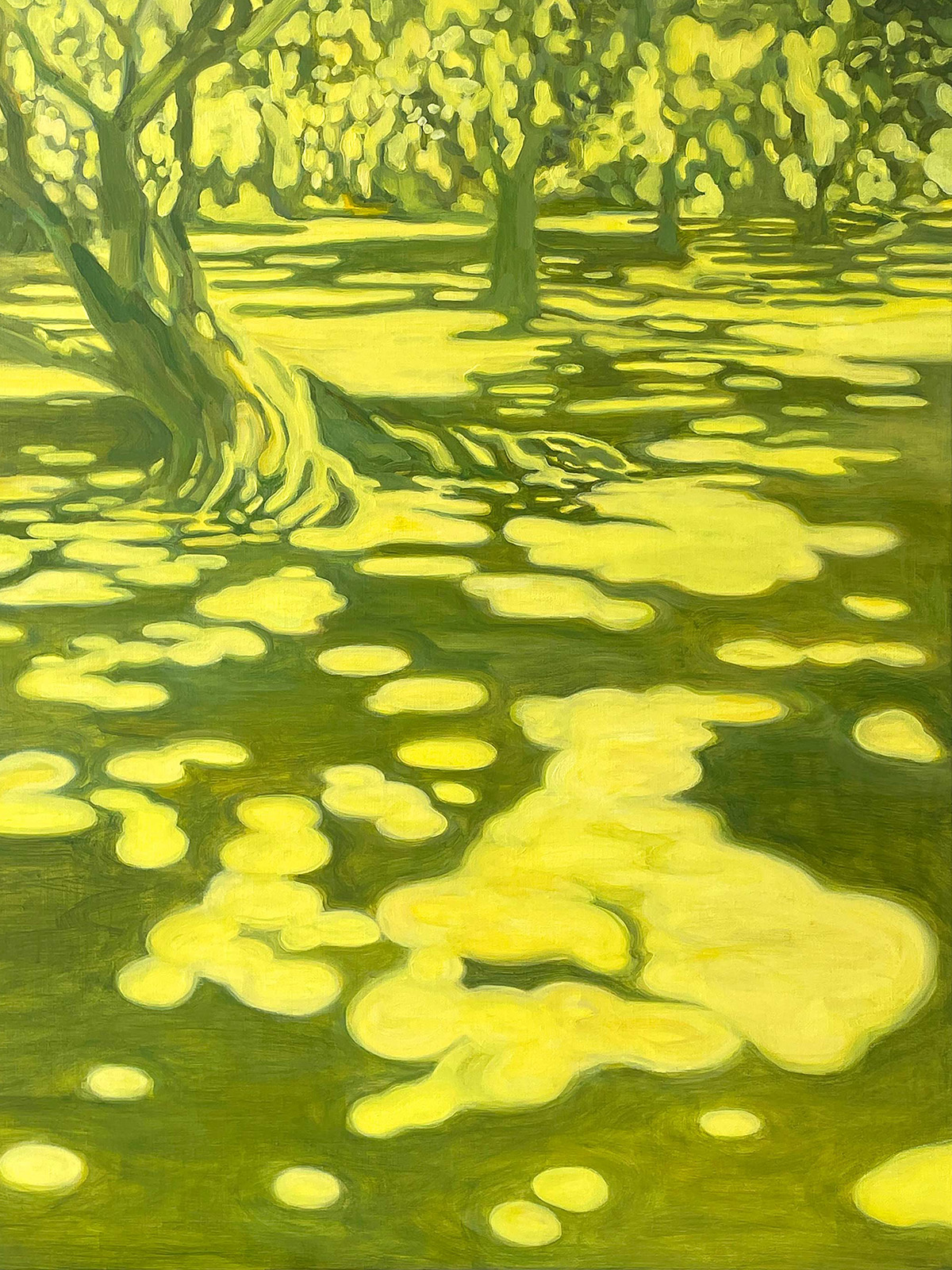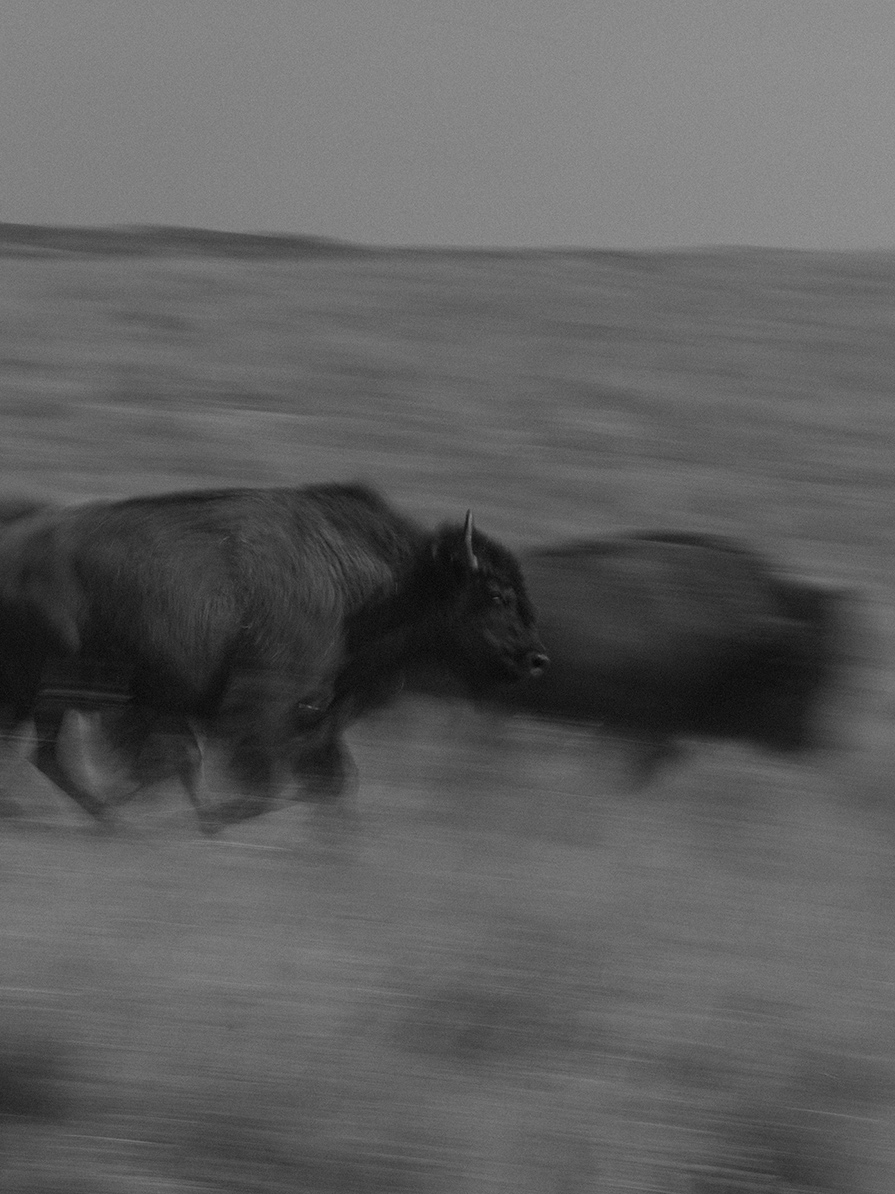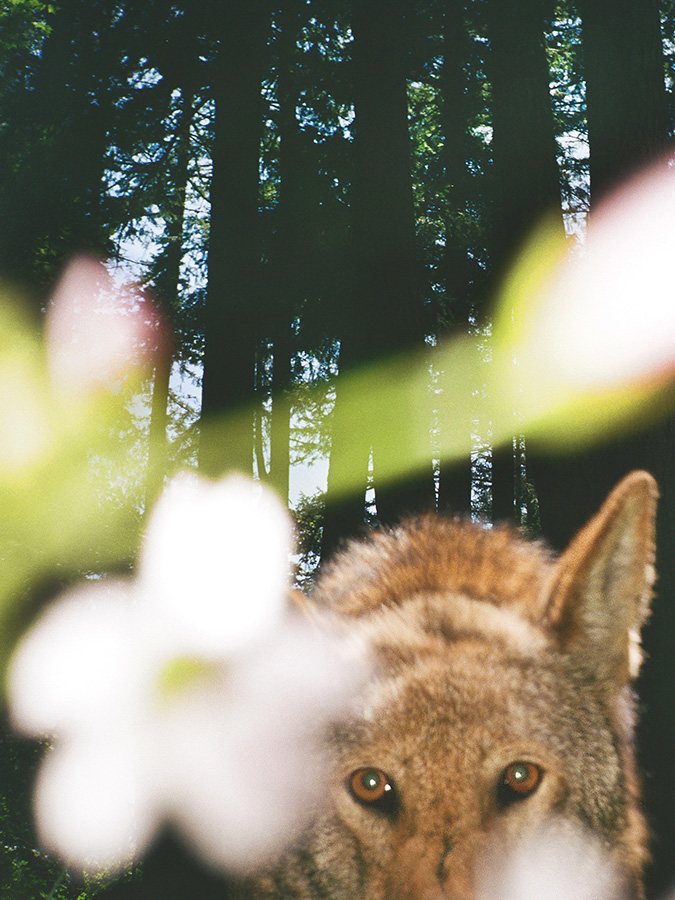
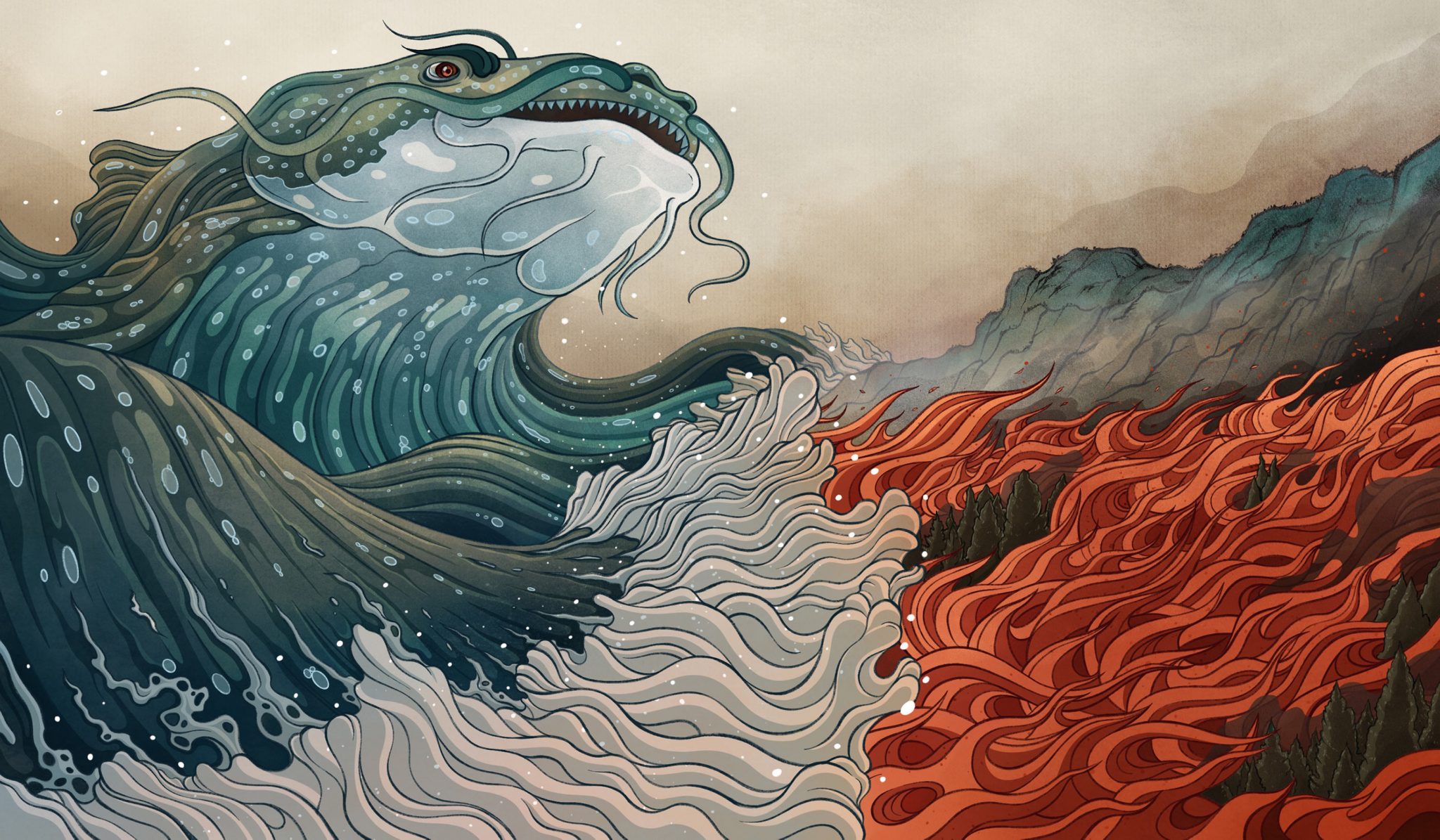

Illustration by Jason Lyon
Thirteen to One
New Stories for an Age of Disaster
by Marie Mutsuki Mockett
Marie Mutsuki Mockett is the author of American Harvest: God, Country, and Farming in the Heartland, a finalist for the Lukas Prize for Nonfiction. Her memoir, Where the Dead Pause, and the Japanese Say Goodbye, was a New York Times Editors’ Choice, a Finalist for the 2016 Pen Open Book Award, and a Finalist for the Indies Choice Best Book for Adult Nonfiction for 2016. She has written for The New York Times, Salon, National Geographic, and Glamour and has been a guest on The World, Talk of the Nation, and All Things Considered on NPR. She teaches fiction and nonfiction at the Rainier Writing Workshop in Tacoma, Washington.
Jason Lyon is a UK-based illustrator from China with a primary focus on editorial illustration. His surrealist work blends elements from nature with current subject matter. Jason has been recognized by the World Illustration Awards and 3×3 Magazine. His clients include: Quanta Magazine, Runner’s World UK, Politico Europe, and The Telegraph Magazine.
Whenever an earthquake strikes Japan, the myth of the giant catfish Ōnamazu reminds people that the living world is full of complex meaning. In the face of repeated natural disasters, Marie Mutsuki Mockett looks to her mother’s homeland to recall stories that could change our relationship with what we call “nature.”
We did not think of September as the start of fire season but as a kind of second summer, a period of prolonged good weather, by which was meant no rain. Even when we had returned to school, we could count on sunbathing, hiking, and going to the beach on weekends. This weather might last through December, and it was a thing in coastal California that we were sure made us special as Californians. The first big California fire I remember was in June of 2008. A few weeks after my father died in a hospital, I woke up one morning and watched ash rain down and gather in the grooves of the brick patio. I had never seen falling ash before. How poetic, I thought at the time. The world was mirroring my grief. A meeting I’d scheduled with the estate lawyer later that week was postponed because he was busy trying to save his home in Big Sur, which was in an evacuation zone. The house burned. That was only thirteen years ago; now we know that every summer and fall is fire season, each worse than the one before, and that this new hell in which we live is likely to continue.
It is now the second week that I have woken up with a sore throat from smoke that has drifted down from Oregon to the small coastal town in California where I’ve come to shelter in place during the pandemic. It was smoky a few weeks before that when lightning ignited three fires within fifteen miles of the room I lived in as a child, with the faded yellow floral curtains my father put up. These days my interactions have mostly been limited to email and social media. During the three fires, we all met online to watch updates from the fire bureau on the blaze, the ever-expanding evacuation zones, and the weather that was projected to cooperate or hinder the efforts of the firefighters. As a writer, I have been following a related conversation between creative people: the superfires sweeping through our beautiful forests and vineyards are unprecedented and tell us that we need a new relationship to what we have called nature. We will need new stories.
Sometimes I tell friends that in the early nineteenth century, there were multiple words for “nature” in Japanese—as many as thirteen. This was before 1853, when Japan was forcibly opened up to trade with the West by the American commodore Matthew C. Perry. I am half Japanese—my mother was born there, and I grew up speaking Japanese with her. I occasionally try to imagine what it would have been like to exist in a culture that celebrated the seasons and natural beauty through painting, gardening, and poetry, only to learn that now, in the fabric of the mind where metaphor is made, one had to put in a couple of loose stitches and gather together previously disparate concepts and phrases into a tight, coagulated pleat. For the Westerners spoke of “natural wonders” and “human nature” and said, “naturally, my dear.” All of these words were cognate in English but not in Japanese. The word shizen is the term for “nature” that most people learn now when they study Japanese, but it did not become standard in the language until the 1890s.
The old words did not fit the new reality, and so everyone adapted. It goes a long way toward demonstrating how language can be a tool—a thing we implement when conditions around us change. While some Westerners consider Japan to have a rigid culture, I have always found it to be highly flexible, and a dense resource of ideas overflowing with images from which to draw.
If this age of repeating natural disasters requires a new relationship to nature aided by fresh stories, what might Japan have to offer? In 2011, I went to Japan to write about the impact of the Great East Earthquake. I was interested in the story of Ōnamazu, a giant catfish said to live beneath the islands of Japan, whose head is located about fifty-three miles northeast of Tokyo at a place called Kashima. The catfish is pinned into place by the Shintō god Takemikazuchi, but when the god dozes off or becomes distracted by a cup of sake, the catfish moves, the ground trembles, and the ocean occasionally revolts in the form of a tsunami. Today there is still a shrine at Kashima, and the tip of Takemikazuchi’s pole protrudes out of the earth.
I went to see the sacred spear and wrote about it for a magazine, but the story was rejected. It was too weird and too specific and too hard to relate to, the editor said, and in the end I wrote the classically digestible story that Asian women are often asked to write, about my relationship with my mother and the natural Japanese landscapes in my illustrated childhood journals.
Reflecting on why one story was favored over the other, I was reminded, as I often am when I write about Japan, of the many times I have been admonished when I’ve asked Japanese people about some cultural practice: “You may not be able to understand us,” or “Your people probably cannot understand us.” In the years that followed, when I mentioned the catfish and the shrine I was often asked by Westerners, “Do modern-day Japanese believe in the catfish?” It’s true the mascot for the Japanese earthquake warning system is a cartoon catfish. Once, when I was visiting Japan, a bullet train I was riding stopped completely and the lights went out. Around me in the dark—we were in a tunnel—cell phones lit up with little gleaming catfish logos, and people whispered, “Jishin da.” “It is an earthquake.” A moment later, our voyage continued.
But no, I am not sure the Japanese ever “believed” in a giant catfish under the earth in the way that people—and by this I mean Western people—mean when they ask the question.
So while I don’t actually know anyone in Japan who would believe in the great catfish, I do know many who might visit the shrine and pay their respects to Takemikazuchi, who pins the catfish to the earth’s core. They would do this, and they would also be grateful for the modern design of Tokyo skyscrapers that allows buildings to sway safely—“like a ship,” an attendant in a hotel once said to me cheerfully, as we looked out the window of my twenty-third-floor room in Tokyo. They would pray to the god Takemikazuchi not because they actually believe that he exists but because to do so puts them in the habit and the mindset of focusing on the earth and disaster, and on planning to keep each other safe.
Would that we, too, could see ourselves as participating in a story in which caring for the earth is not only desirable but also possible. It was Alexis de Tocqueville who noted the American fluency in and habit of communicating through law. “Judicial language,” he wrote, “becomes, in a way, the common language.” And maybe the law will be the first way in which the stories that see us aiding the earth will be framed in such a way that we believe them, and want to be actors in them. The movement to advance the rights of nature has, around the world, granted several natural wonders the same rights as living entities. Think of Erin Brockovich helping residents of the Southern California town of Hinkley sue Pacific Gas & Electric Company for allowing contaminated drinking water to sicken them; she was protecting people. But now Lake Erie, which has been granted rights equal to those of a human by the citizens of Toledo, Ohio, could file a similar suit with the aid of its own crusading Brockovich-like attorney. In New Zealand, the Whanganui River is similarly protected, along with the Ganges and Yamuna rivers in India.
But I think our imagination needs more than a new law to move us to change how we see and how we and the world are seen. The story of a polluted river with rights now on par with those of a human being makes me think of the beloved Japanese anime Spirited Away, in which a young heroine works in a bathhouse to clean the spirits, among whom is a dirty river god who sometimes takes the form of a river, sometimes a dragon, and sometimes, as befits a romantic lead, a handsome boy. The story is popular here in the West, even though it is deeply rooted in Japan’s indigenous religion, Shintō, which is around two thousand years old and which envisions, among many things, a pantheon of gods who can occupy trees, mountains, rocks, and, yes, rivers.
Japan has never fully retreated from its relationship to Shintō, yet the ability to imagine a river as a god who can play a role in a hugely successful cultural export did not prevent Japan from dismantling almost all of its wilderness, or from guzzling carbon fuels on a path to modernity. The presence of the thirteen words for nature is not some kind of ancient magic spell once perfected and now lost. Japan’s stories—those that came before Commodore Perry and those fashioned more recently from older cultural roots—also haven’t been enough to prevent disasters there.
I think about Amitav Ghosh, who wrote The Great Derangement, billed as a book on “climate change and the unthinkable” but which is actually about something even more ambitious. After recounting an unusual tornado he witnessed in 1978 in Delhi, Ghosh writes, “[W]e are now in an era that will be defined precisely by events that appear, by our current standards of normalcy, highly improbable: flash floods, hundred-year storms, persistent droughts…” It is also, according to Ghosh, a reality which is less a shock and more a part of the structure of our world that was always there. “For what it suggests—indeed proves—is that non-human forces have the ability to intervene directly in human thought. And to be alerted to such interventions is also to become uncannily aware that conversations among ourselves have always had other participants: it is like finding out that one’s telephone has been tapped for years, or that the neighbors have long been eavesdropping on family discussions.” We have been riding the skin of a catfish all this time; visualize him and we can visualize our relationship to the world beneath our feet.
We have been riding the skin of a catfish all this time; visualize him and we can visualize our relationship to the world beneath our feet.
Ōnamazu, the giant catfish, became particularly popular as a subject for woodblock print artists after the Ansei earthquake in 1855, which was exceptionally cruel to the city of Edo, the old name for modern-day Tokyo. In some of the prints, he’s crying as he is scolded by humans who have lost their homes due to his subterranean twitching. In some cases, Takemikazuchi is removed from his powerful position and replaced by Amaterasu—the sun goddess, whose radiant power would be so inspiring to Japan’s fascist movement three generations later. In yet other prints, merchants and carpenters rejoice because the wide-scale destruction of Edo has brought them wealth in the form of new contracts for construction. The catfish Ōnamazu is thus a troublemaker, but also a great equalizer. “In the larger scheme of things,” writes the scholar Gregory Smits, “many residents of Edo regarded the Ansei earthquake as a purposeful attempt by the cosmic forces to rectify a society out of balance.” Given that Ōnamazu played a part in this “equalizing,” should we see him as good or bad?
Recently, I taught a class to my MFA students on Japanese story structure. We began with fairy tales and children’s stories, then read English translations of contemporary novels. I explained that Judeo-Christian notions of evil aren’t generally present in these books the way they are in the West. Ōnamazu is part of this framework and shouldn’t be considered some leviathan we need to kill in order to put an end to earthquakes. I would write that his power is “dual,” except even to use that word would be incorrect. His power is multifaceted, and therefore to think of stopping or conquering him would be the wrong way to relate to the catfish altogether. It is this multifaceted quality that can feel weird to Westerners visiting a sacred space in Japan. I mean, what exactly is happening at Kashima Shrine?
I only realized as an adult that my early exposure to both Western and Japanese stories as a child had greatly shaped my view of stories in my imagination. My mother often read to me in Japanese, and I remember one book my grandfather sent to us, called Gon the Fox, written by Niimi Nankichi, who was born in the same town where my mother grew up and is sometimes called the Hans Christian Andersen of Japan. The story was about a fox who steals some food from a man; the man had intended the food for his starving mother. She dies. The fox, Gon, feels remorse and tries to make up for his transgression through a series of secret gifts but is shot by the man. It is a simple story of a relationship and good intentions gone awry. It made me cry so hard, my mother read it only once. She was also furious. How could she explain this Gon the Fox to me when the stories I was told by the culture in which I was raised insisted I should aim for a happy ending?
Sometimes when I talk to audiences about the differences between Japanese and Western fairy tales, someone—usually a mother—will ask me, “How do you keep your child from being scared?” I always think back to my mother and her rage at Gon the dead fox, and for a long time, I wasn’t truly sure how to answer the question. Now I say, “You don’t.” Because I am now very clear: disaster is endemic to the structure of the world in which we live.
Things should scare us.
After the Great East Earthquake and subsequent tsunami struck Japan in 2011, it became common to hear in the news some version of “Japan is a modern country with ancient roots.” Perhaps this was to explain the preponderance of ghostly survivors sighted in Tōhoku, or perhaps it was because of the taxi drivers who ferried these ghosts to the foundations of their homes, swept away by the water. Or perhaps the ghosts of the deceased provoked it—as they greedily infiltrated the bodies of mediums, who were accustomed to communicating with the dead but never with so many ghosts at once—and the priests who exorcized them. The implication was that there is a modern place to which modern people go, and in that place, there are no ghosts.
“The ghosts that hover just above his charged and elemental pages are a reminder of how much this land of order remains ruled by things that can’t be seen,” writes Pico Iyer of Richard Lloyd Parry’s 2017 book, Ghosts of the Tsunami, a harrowing account of devastation and grief. “Japan, he reminds us, is an often-22nd-century society largely governed by the past.”
I remember parroting the same answer, too, when interviewed about my book Where the Dead Pause, and the Japanese Say Goodbye, which examines Japanese traditions and practices for confronting grief and wide-scale disaster. I answered this way partly because I knew I was supposed to. My mother would hear me and would reply, “No. It is not old-fashioned. It is wisdom.”
I am ashamed to say that I only partly paid attention to her. I knew that the opinions of men mattered more than anyone else’s. I knew they were busy telling us that Japan had an ancient heart beating at its core and this was why the ghosts were still walking around. I knew, and know, how important it is to deliver answers that appear intellectual. But actually, my mother was right all along. The ghosts are there, the thirteen words of nature are there, the giant catfish is still there—not because the people who conjured them lack intellect, but because these things are wisdom. To paraphrase the writer Bruno Latour, we have never been modern people who escaped nature and our human nature.
It is true that we need a new framework for stories—one that can amplify our imaginations and teach us how to relate to one another and the natural world so that we might, going forward, avoid the superfires which have caused and will no doubt continue to cause severe destruction.
We train ourselves to “wipe out” plagues and “defeat” enemies. But assuaging the metaphoric giant catfish will require us to do more than think in polar opposites. It is less the relationship with “ancient Japan” from which I think we need to borrow—less the animism of Shintō—and more the flexibility that gave rise to the animism in the first place. Envisioning Ōnamazu will require us to be adaptable, to find the part of our imagination that can go from one to thirteen. We will need to look again at the stories that have long been with us and long been around us to begin to fashion new ones. We will need not only new stories but perhaps also new words to build those stories that will allow us to see the world again.
